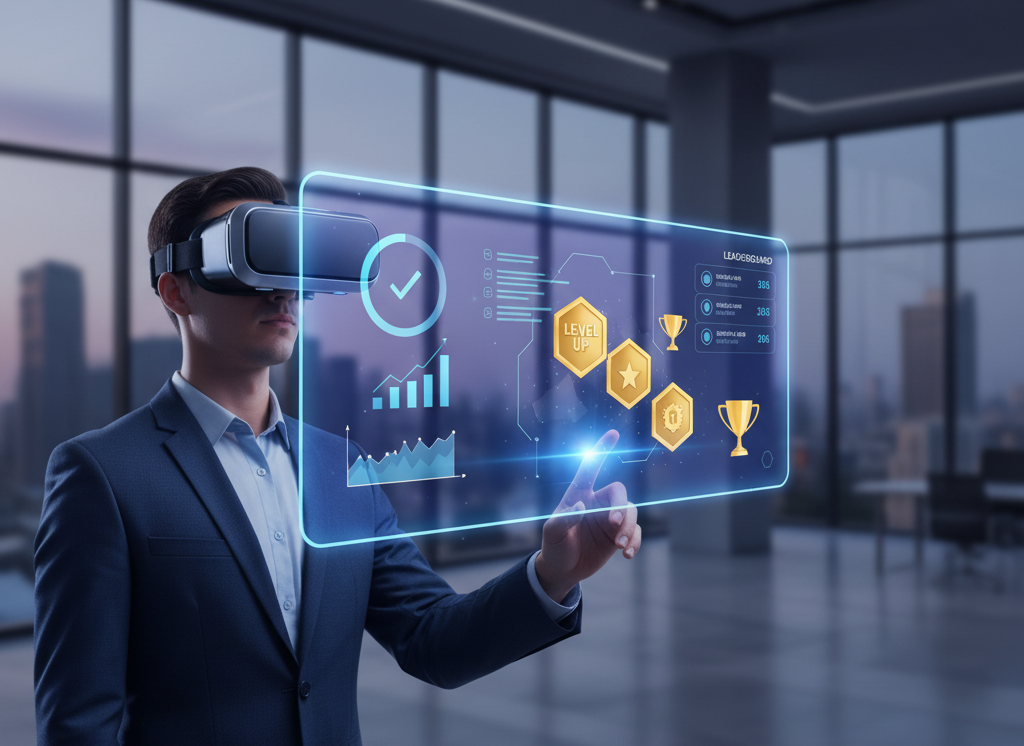Gamification and AR: Engaging Customers Through Interactive Experiences

Marketing is no longer about broadcasting messages to passive audiences. Today’s customers, whether consumers buying sneakers or executives choosing enterprise software, expect experiences that feel participatory, rewarding, and even fun. Gamification and augmented reality (AR) sit at the intersection of this shift. They transform engagement from something transactional into something immersive, encouraging customers to interact willingly with brands while generating valuable behavioral data.
For B2B marketers in particular, these tactics may sound unconventional. After all, gamification is often associated with fitness apps or mobile games, and AR with flashy consumer campaigns. But when framed strategically, these approaches can deepen buyer engagement, differentiate complex offerings, and provide insights that traditional campaigns can’t.
This article explores how gamification and AR are changing the engagement landscape, why they matter for both B2C and B2B marketers, and how forward-thinking brands can harness them to build loyalty and drive revenue.
The Psychology Behind Gamification
Gamification is not about turning everything into a game. It’s about tapping into innate human motivations, competition, achievement, recognition, and reward. Points, leaderboards, challenges, and badges work because they create a sense of progress and accomplishment. More importantly, they transform engagement into an activity customers choose to return to, rather than an obligation.
In marketing, this matters because it reframes the customer experience. Instead of “being marketed to,” the audience feels like they are playing, achieving, or exploring. This subtle shift removes resistance. Engagement feels voluntary, yet the outcomes, brand awareness, deeper product familiarity, and stronger loyalty, serve business objectives.
In B2B contexts, gamification can also address a common challenge: lengthy sales cycles. Breaking down complex buyer journeys into smaller, interactive milestones can keep prospects engaged and motivated over weeks or months of consideration.
The Rise of Augmented Reality
While gamification motivates behavior, augmented reality (AR) enhances perception. AR overlays digital content onto the physical world through mobile devices or wearables. Done well, it makes interactions more tangible and memorable.
AR is not just a gimmick, it addresses the need for visualization and context. For consumers, this might mean trying on virtual sneakers or previewing furniture in their living room. For business buyers, it could mean simulating how new industrial machinery fits into a factory floor plan or previewing software workflows in a real-world environment.
This visualization bridges the “imagination gap.” Customers no longer need to interpret static brochures or abstract presentations; they can experience the product in their own space and terms. That emotional and cognitive clarity builds confidence, which directly impacts purchasing decisions.
Gamification and AR in B2C: Familiar Milestones
Before examining B2B opportunities, it’s worth looking at consumer campaigns that set the standard:
- Pokémon GO: Launched in 2016, it combined gamification and AR at scale. Players earned rewards, completed challenges, and explored their physical environment, blurring digital and real-life interaction. For marketers, it proved that AR could drive mass engagement and sustained user activity.
- IKEA Place: IKEA’s AR app lets customers preview furniture in their homes. This not only increased engagement but also reduced purchase hesitation and returns. The campaign reframed AR as a functional, problem-solving tool, not just a novelty.
Both examples highlight a key theme: customers don’t perceive these campaigns as “marketing.” They see them as useful, entertaining, or rewarding experiences that happen to deepen their relationship with the brand.
Why Gamification and AR Work in B2B
At first glance, a CFO shopping for enterprise software may not seem like the type to be swayed by gamification or AR. Yet, decision-makers are people too. They respond to the same psychological drivers and immersive experiences that make consumer campaigns successful.
Here’s how gamification and AR translate into the B2B world:
1. Complex Product Education
Enterprise solutions often have steep learning curves. Gamification can simplify training by turning it into a series of challenges or progress markers. AR can then visualize workflows, making abstract solutions tangible. For example, cybersecurity vendors could use AR simulations to show how threats are detected and neutralized in real time, making technical concepts accessible to non-technical stakeholders.
2. Event Engagement
Trade shows and webinars are staples of B2B marketing. Gamified elements like scavenger hunts, quizzes, or interactive leaderboards can encourage participants to explore more booths, attend more sessions, or network actively. Incorporating AR at booths. say, a holographic demo of a product, creates memorability and increases dwell time.
3. Data Collection and Behavioral Insights
Every interaction within a gamified or AR environment generates data. How long do prospects spend on certain tasks? Which features do they engage with most? This behavioral insight can refine lead scoring models and guide sales follow-ups. Unlike generic intent data, this information comes directly from active engagement, making it both verified and predictive.
4. Strengthening Internal Buy-In
B2B purchases involve multiple stakeholders. Gamification can help align them by turning consensus-building into an interactive process. Imagine a procurement team earning points as they complete product evaluations or simulations together. The process becomes less bureaucratic and more collaborative, reducing friction in the buying committee.

B2B Examples of Gamification and AR in Action
While B2C campaigns get more headlines, B2B innovators are already experimenting with these tools:
- Siemens AR Demos: Siemens has used AR to help industrial clients visualize how large equipment would fit and operate within their facilities. This reduces uncertainty in capital-intensive decisions.
- Deloitte Leadership Academy: Deloitte built a gamified training platform that uses badges, leaderboards, and challenges to keep professionals engaged in continuous learning. While internal, it demonstrates how gamification can sustain engagement with complex, long-term content.
- Cisco’s Social Media Training: Cisco launched a gamified program for employees and partners to learn social media best practices. Points, levels, and recognition motivated participants to complete training, creating better brand advocates.
These examples reveal a spectrum: AR to contextualize products, gamification to sustain attention, and both working together to create engagement loops that feel rewarding rather than forced.
From Engagement to Loyalty: The Bigger Picture
The true power of gamification and AR is not in isolated campaigns but in the cumulative effect they create. When customers feel that every interaction with a brand is valuable, rewarding, or fun, loyalty follows naturally.
In B2B, loyalty translates to long-term contracts, renewals, and advocacy. Decision-makers who experience a brand as innovative and engaging are more likely to recommend it internally and externally. Moreover, the data collected through these interactions enhances personalization. Marketing teams can tailor content to each buyer’s interests and behaviors, creating a virtuous cycle of relevance and engagement.
Overcoming Common Misconceptions
Some B2B marketers hesitate to adopt gamification or AR because of misconceptions:
- “It’s too gimmicky.” Done poorly, yes. But when aligned with customer needs, like visualizing a product’s fit or simplifying training, these tools add practical value.
- “Our buyers are too serious for games.” Gamification is not about playfulness for its own sake. It’s about motivation and engagement, which matter to any decision-maker navigating complex processes.
- “It’s too expensive.” AR and gamification platforms are more accessible than ever, with scalable solutions that can be tailored to budget. Moreover, the long-term data and loyalty benefits often outweigh the initial costs.
Practical Steps for B2B Marketers
For B2B teams curious about experimenting with gamification and AR, here are actionable steps:
- Define the objective. Is the goal to educate, collect data, or drive event participation? Clear goals prevent gimmicky execution.
- Start small. Pilot a gamified quiz in a webinar or test an AR product demo for a specific vertical.
- Leverage data. Treat every interaction as a behavioral signal. Use it to refine targeting and personalization.
- Integrate with existing channels. Gamification and AR are not standalones, they should complement email, social, events, and ABM campaigns.
- Measure engagement depth. Beyond clicks, look at time spent, repeat visits, and progression through gamified tasks as indicators of buyer readiness.
Conclusion: Marketing That Doesn’t Feel Like Marketing
Gamification and AR succeed because they don’t feel like traditional marketing. Customers perceive them as rewarding experiences that add value, not as intrusive campaigns. In consumer markets, this builds brand affinity and sales. In B2B, it sustains engagement through long sales cycles, provides behavioral insights, and helps multiple stakeholders visualize value.
As competition for attention intensifies, these strategies offer a path forward. They bridge the gap between engagement and loyalty, between data and insight, and between marketing as a function and marketing as an experience. For B2B marketers willing to experiment, gamification and AR are not just creative add-ons, they are powerful tools for building trust, capturing attention, and driving measurable growth.